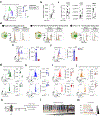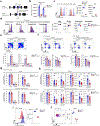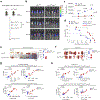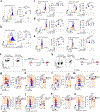Transgelin 2 guards T cell lipid metabolism and antitumour function
- PMID: 39443795
- PMCID: PMC11949091
- DOI: 10.1038/s41586-024-08071-y
Transgelin 2 guards T cell lipid metabolism and antitumour function
Abstract
Mounting effective immunity against pathogens and tumours relies on the successful metabolic programming of T cells by extracellular fatty acids1-3. Fatty-acid-binding protein 5 (FABP5) has a key role in this process by coordinating the efficient import and trafficking of lipids that fuel mitochondrial respiration to sustain the bioenergetic requirements of protective CD8+ T cells4,5. However, the mechanisms that govern this immunometabolic axis remain unexplored. Here we report that the cytoskeletal organizer transgelin 2 (TAGLN2) is necessary for optimal fatty acid uptake, mitochondrial respiration and anticancer function in CD8+ T cells. TAGLN2 interacts with FABP5 to facilitate its cell surface localization and function in activated CD8+ T cells. Analyses of ovarian cancer specimens revealed that endoplasmic reticulum (ER) stress responses induced by the tumour microenvironment repress TAGLN2 in infiltrating CD8+ T cells, thereby enforcing their dysfunctional state. Restoring TAGLN2 expression in ER-stressed CD8+ T cells increased their lipid uptake, mitochondrial respiration and cytotoxic capacity. Accordingly, chimeric antigen receptor T cells overexpressing TAGLN2 bypassed the detrimental effects of tumour-induced ER stress and demonstrated therapeutic efficacy in mice with metastatic ovarian cancer. Our study establishes the role of cytoskeletal TAGLN2 in T cell lipid metabolism and highlights the potential to enhance cellular immunotherapy in solid malignancies by preserving the TAGLN2-FABP5 axis.
© 2024. The Author(s), under exclusive licence to Springer Nature Limited.
Conflict of interest statement
Competing interests: J.R.C.-R. holds patents on the targeting of ER stress responses for the treatment of disease, as well as on the use of immune modulators for OC therapy. J.R.C.-R. is a scientific consultant for Moderna, Immagene, Autoimmunity Biologic Solutions, and Emerald Bioventures, and holds stock options in Vescor Therapeutics. D.Z. reports institutional grants from Merck, Genentech, AstraZeneca, Plexxikon, and Synthekine, and personal fees from AstraZeneca, Xencor, Memgen, Takeda, Synthekine, Immunos, Tessa Therapeutics, Miltenyi, and Calidi Biotherapeutics. D.Z. owns a patent on use of oncolytic Newcastle Disease Virus for cancer therapy. J.R.C.-G. has stock options in Compass Therapeutics, Anixa Biosciences, and Alloy Therapeutics; receives licensing fees from Anixa Biosciences for the patent of FSHCER T cells; receives honorarium from Alloy Therapeutics; has intellectual property with Compass Therapeutics and Anixa Biosciences; and is co-founder of Cellepus Therapeutics, a company that develops allogeneic γδ CAR T cells. All other authors declare no potential conflicts of interest.
Figures
















Update of
-
Transgelin 2 guards T cell lipid metabolic programming and anti-tumor function.Res Sq [Preprint]. 2023 Dec 14:rs.3.rs-3683989. doi: 10.21203/rs.3.rs-3683989/v1. Res Sq. 2023. Update in: Nature. 2024 Nov;635(8040):1010-1018. doi: 10.1038/s41586-024-08071-y. PMID: 38168227 Free PMC article. Updated. Preprint.
References
MAIN TEXT REFERENCES
Methods References
-
- Lee AH, Scapa EF, Cohen DE & Glimcher LH Regulation of hepatic lipogenesis by the transcription factor XBP1. Science 320, 1492–1496 (2008). https://doi.org:320/5882/1492 [pii] 10.1126/science.1158042 - DOI - PMC - PubMed
MeSH terms
Substances
Grants and funding
LinkOut - more resources
Full Text Sources
Medical
Research Materials
Miscellaneous

